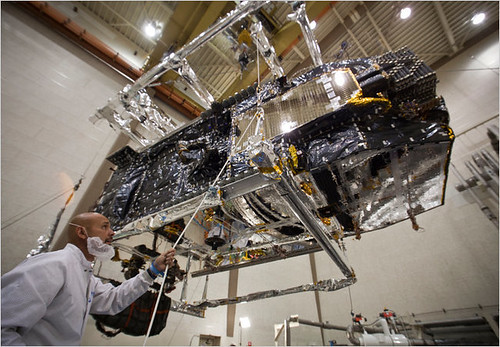Satcom PR: Meh.
The newspaper’s pretty thin today. Many people are away, so there are less ads to run. Reports and editors are on vacation, too. Less content overall.
So the timing must be just right for some satcom P.R., right? Sure, let’s run that piece! First page of the business section in today’s New York Times — a story on satellite, "Tapping the Web from 22,000 Miles Up."

Great press for the folks at ViaSat and HughesNet, but you could have recycled a story from 5, 10 or even 15 years ago. The only difference is they’re actually serving a million customers. Some quotables…
“One advantage satellite has is ubiquity,” Arunas G. Slekys, vice president for Hughes Network Systems, said. “The cost of reaching you with a satellite dish is independent of where you are. Fiber or cable is labor-intensive and dependent on distance.”
As to satellite’s potential in rural regions, “clearly, there’s an unserved market,” Mr. Slekys said. “And it’s not as though they have terrestrial or satellite. They only have satellite as a choice.”
If rural is "unserved," WTF have you been doing? I’ve experienced "rural" in Upstate New York, and in Prince Edward Island, Canada. No comparison: PEI wins with broadband. People in Vermont have been waiting for years to get a price-competitive services from satcom. Nothing yet. National Broadband Plan? Satcom didn’t get much. Let’s all cry together…
Even so, the satellite companies contend that they should have received a bigger piece of the $7.2 billion in federal stimulus money for extending broadband service to underserved areas in the United States. Of its $2.5 billion share of the stimulus funds, the Agriculture Department is allocating just $100 million in grants to satellite companies.
Thomas E. Moore, chief of WildBlue, said satellite technology would be able to serve thousands more rural residents than terrestrial services at a fraction of the cost. He cited a $28 million grant to a nonprofit group in North Carolina to extend fiber to 420 schools and libraries. That same grant could have instead directly served 70,000 residents in North Carolina through satellite service, Mr. Moore said.
What, can’t lower the price? Gotta keep the 80% margins. I’d rather see the profits generated from television broadcasting used to provide broadband Internet service to under-served markets. If they had historical data on how they’re "subsidizing" this type of service, perhaps they’d get some help from the Broadband Plan.
Hey, at least Space Systems/Loral get good press: they’re building both Ka-band birds for ViaSat and Hughes.
Overall, the piece is typically well-balanced and well done. For the satcom guys, it’s just another example of their press people not being taken seriously by the MSM. In other words, who cares?
